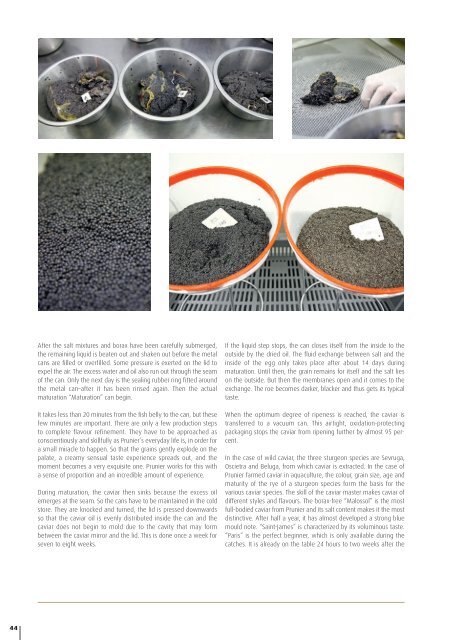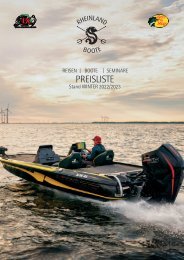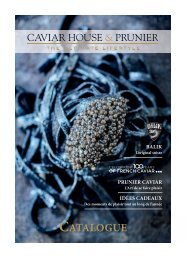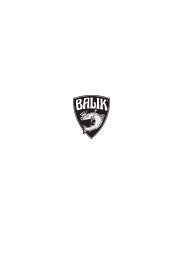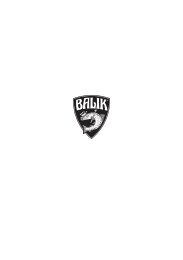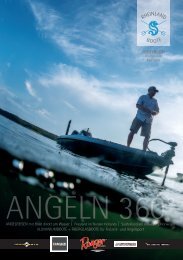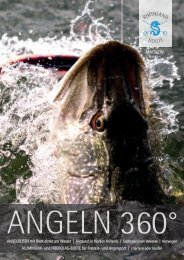Caviar House & Prunier Catalog 2020
You also want an ePaper? Increase the reach of your titles
YUMPU automatically turns print PDFs into web optimized ePapers that Google loves.
PRUNIER MANUFACTORY<br />
After the salt mixtures and borax have been carefully submerged,<br />
the remaining liquid is beaten out and shaken out before the metal<br />
cans are filled or overfilled. Some pressure is exerted on the lid to<br />
expel the air. The excess water and oil also run out through the seam<br />
of the can. Only the next day is the sealing rubber ring fitted around<br />
the metal can–after it has been rinsed again. Then the actual<br />
maturation “Maturation” can begin.<br />
It takes less than 20 minutes from the fish belly to the can, but these<br />
few minutes are important. There are only a few production steps<br />
to complete flavour refinement. They have to be approached as<br />
conscientiously and skillfully as <strong>Prunier</strong>’s everyday life is, in order for<br />
a small miracle to happen. So that the grains gently explode on the<br />
palate, a creamy sensual taste experience spreads out, and the<br />
moment becomes a very exquisite one. <strong>Prunier</strong> works for this with<br />
a sense of proportion and an incredible amount of experience.<br />
During maturation, the caviar then sinks because the excess oil<br />
emerges at the seam. So the cans have to be maintained in the cold<br />
store. They are knocked and turned, the lid is pressed downwards<br />
so that the caviar oil is evenly distributed inside the can and the<br />
caviar does not begin to mold due to the cavity that may form<br />
between the caviar mirror and the lid. This is done once a week for<br />
seven to eight weeks.<br />
If the liquid step stops, the can closes itself from the inside to the<br />
outside by the dried oil. The fluid exchange between salt and the<br />
inside of the egg only takes place after about 14 days during<br />
maturation. Until then, the grain remains for itself and the salt lies<br />
on the outside. But then the membranes open and it comes to the<br />
exchange. The roe becomes darker, blacker and thus gets its typical<br />
taste.<br />
When the optimum degree of ripeness is reached, the caviar is<br />
transferred to a vacuum can. This airtight, oxidation-protecting<br />
packaging stops the caviar from ripening further by almost 95 percent.<br />
In the case of wild caviar, the three sturgeon species are Sevruga,<br />
Oscietra and Beluga, from which caviar is extracted. In the case of<br />
<strong>Prunier</strong> farmed caviar in aquaculture, the colour, grain size, age and<br />
maturity of the rye of a sturgeon species form the basis for the<br />
various caviar species. The skill of the caviar master makes caviar of<br />
different styles and flavours. The borax-free “Malossol” is the most<br />
full-bodied caviar from <strong>Prunier</strong> and its salt content makes it the most<br />
distinctive. After half a year, it has almost developed a strong blue<br />
mould note. “Saint-James” is characterized by its voluminous taste.<br />
“Paris” is the perfect beginner, which is only available during the<br />
catches. It is already on the table 24 hours to two weeks after the<br />
catch. Salt and roe have not yet embraced each other, and so is the<br />
taste experience: first you taste the salt, then the fishy egg yolk,<br />
almost creamy, a unique snapshot. Fresh and uncomplicated in taste<br />
is “Tradition”, ideal for those who used to like Sevruga.<br />
<strong>Prunier</strong> thus offers lovers of caviar from the Caspian Sea a worthy<br />
alternative. Those who like Oscietra will go for “Saint-James”, those<br />
who love Russian caviar will be well advised to choose “Malossol”.<br />
And fans of Imperial are at home at “Héritage”.<br />
Every single sturgeon is recorded in aquaculture: What generation<br />
he comes from, how much roe he has been fed with, and how much<br />
roe he has produced.<br />
Many years of experience, strict quality controls, care and a sure<br />
instinct let even experts fail to distinguish the edible luxury of <strong>Prunier</strong><br />
from wild caviar.<br />
“Quality is not an act,<br />
it is a habit.”<br />
- Aristoteles -<br />
44<br />
45


